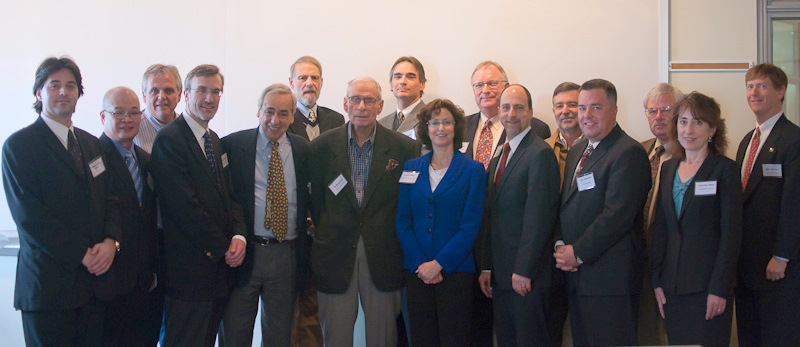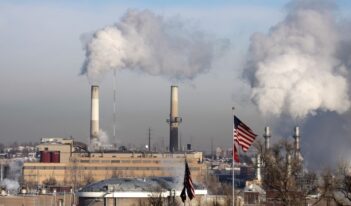
Special event features robust discussion on how to ensure safety with limited regulatory funds.
On November 18, 2010, the Wharton Risk Management Center, in collaboration with the Penn Program on Regulation, hosted a workshop on the Roles for Third Parties in Improving Implementation of EPA’s and OSHA’s Regulations on the Management of Low-Probability, High-Consequence Process Safety Risks. The day-long workshop brought researchers together with government officials, industry experts, and representatives from non-governmental organizations.
In late October, a massive oil refinery near Elizabeth, New Jersey sent plumes of fire into the air, visible for miles around. The fire was intentional, part of an emergency response to reduce pressure from a fuel backup that had occurred from an unexplained power failure. The plant is located just off the New Jersey Turnpike and employs over 800 workers. “The potential for an explosion was there,” the fire chief said.
Fortunately, there was no explosion and no one was injured. But the power failure and resulting fuel backup and fire are reminders of the extreme risks involved in certain industries – what experts call “Low-Probability, High-Consequence Process Safety Risks.” Perhaps not surprisingly, the Sierra Club released a statement calling for tighter oversight of the New Jersey refinery.
Underlying the public cries for better or increased inspections that often follow an industry disaster or near-disaster is a fundamental problem of virtually every regulatory agency and regulated industry: the number of regulated firms far exceeds the resources of agencies to inspect those firms.
The resulting challenge – how to improve safety given regulatory agencies’ limited resources – is the focus of much of the work of the Penn Program on Regulation (PPR), an interdisciplinary, university-wide program that analyzes regulatory policy problems and alternative strategies for solving them.
Last year, several PPR faculty members published a book, Import Safety, which resulted from a PPR conference that examined in large part how to involve the private sector in increasing the safety of imported goods. This fall, PPR faculty received a grant from the Robert Wood Johnson Foundation to help improve OSHA’s ability to select workplaces for inspection so it can deploy its limited recourses more effectively to reduce injuries and fatalities. And in November – just weeks after the New Jersey refinery incident – PPR co-hosted a workshop with the Wharton Risk Management and Decision Processes Center to address a potential solution to the perennial resource shortage: using third party inspections to reduce the risk of accidents and disasters in regulated industries.
The day-long workshop, entitled “Roles for Third Parties in Improving Implementation of EPA’s and OSHA’s Regulations on the Management of Low-Probability, High-Consequence Process Safety Risks,” brought researchers together with government officials, industry experts, and representatives from non-governmental organizations. The workshop grew out of a paper by Isadore “Irv” Rosenthal, a senior research fellow at the Wharton Risk Management and Decision Processes Center, as well as a series of studies on the feasibility of third party inspections conducted by Rosenthal and his colleagues at the Center beginning over a decade ago.
“The challenge of regulation is daunting,” explained Cary Coglianese, the Edward B. Shils professor of law and professor of political science at the University of Pennsylvania and director of the Penn Program on Regulation. “Therefore you have to look at innovative alternatives. Third party auditing is a prime candidate.” He noted, however, that third party audits also can pose their own challenges.
The first of the workshop’s three panels focused on the distinct challenges of using third party inspectors. For example, who pays for the inspection? If the company pays, can the company’s relationship with the inspector be set up in a way that avoids a conflict of interest? What is the relationship between the third party and the regulatory agency – particularly in light of the fact that the third party has no inherent authority to enforce the regulations?
The next panel examined how third party inspections could be combined with insurance protection to encourage firms to reduce their safety risks. “Since the government can’t be everywhere all the time, the question is, ‘What can the government do to create incentives for the private sector to police itself?’” Coglianese said. Howard Kunreuther, the James G. Dinan professor of business and public policy at Wharton and co-director of the Wharton Risk Center, explained that a mandatory insurance scheme could create a market incentive whereby firms that take steps to reduce risk would be rewarded with lower insurance premiums. “Because individuals tend to focus on short-term horizons and often regard potential disasters as below their threshold of concern, well-enforced long-term insurance contracts that include short-term economic incentives are needed,” Kunreuther said.
The final panel focused on the need to assess the effectiveness of third party auditing from a societal perspective and the challenges associated with integrating such audits into a larger system of process safety regulation. Many of the same challenges facing third party inspectors also confront government inspectors, such as how to determine during discrete visits how well a company manages its overall process safety “system” over time.
Despite the challenges to deploying third party inspectors to increase safety, Rosenthal remained optimistic. Given that the United States is faced with decreasing resources for regulatory enforcement, he said, it seems likely that firms will need to be encouraged to assist in the process of keeping themselves within the law.



